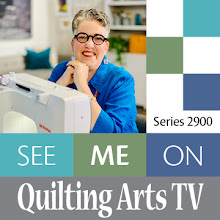Nearly all quilt shows require a 4" hanging sleeve for quilts exhibited. This 4" size accommodates most hanging rods or slats used at shows. Lake Norman Quilters will have its first quilt show November 2-3, and there are some quilters in our group who have never exhibited a show before who have asked about how to make a sleeve to hang their quilts. So here are some basic directions for the process I use. For a copy of these directions in a PDF format that can be printed and distributed, click
here.
1. Measure the top edge of your quilt, where the sleeve will go, about 1/2" from the top. My quilt measures 13".
See photo below.
2. Cut a strip that is 9" wide and the width of your quilt plus 1" (for my quilt, this is a rectangle 9" x 14").
3. Fold in the short ends 1/2" and press. Fold in again 1/2" and press.
See photo below.
4. Sew a seam along these short ends.
See photo below.

5. Fold the strip in half with the wrong sides together, and press. Note that by using this method, you do not have to turn the tube inside out after you sew it together. If you have a wide quilt, and a long sleeve tube, it can be difficult to turn it right side out. This way, you don't have to, because the seam is hidden between the sleeve and the quilt backing.
6. Along the raw edge, stitch the long edge together with a 1/2" seam.
See photo below.
7. Press the seam open, center it, and press.
See photo below.
8. Along one of the long edges, fold down and press about 1/4".
See photo below. This allows for a little slack so the quilt will hang better on a rod or slat. Without this slack on the back, you may have a buldge on the front of the quilt where the hanging rod goes through. You can see this slack more clearly on the side view photo below.


9. Pin the sleeve to the back of the quilt, about 1/2" from the top.
See photo below. Take care to place the sleeve low enough that it will not show from the front once the rod is inside and the weight of the quilt pulls the sleeve up toward the top of the quilt. This is even more of an issue if the quilt is uneven at the top, as mine is, rather than straight.

10. Hand-stitch the sleeve to the quilt.
See photo below. Go around all four edges, even the short sides. Your stitches should only go through the backing and the batting. You should not see them on the front of the quilt.

11. To display your quilt at home, place a dowel rod, metal cafe curtain rod, or a strip of lath (wood slat) through the sleeve. Nail nails or place screws into your wall, and prop the rod on top.



































